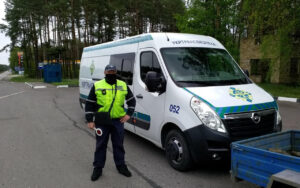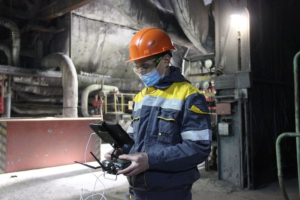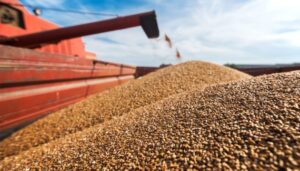
The State Service of Ukraine for Transport Safety (DSBT, Ukrtransbezpeka) will soon introduce the Smart-Tacho system, which reads, analyzes, and records violations of drivers’ work and rest regulations, said the head of Ukrtransbezpeka, Mykyta Lagunin, in an interview with the agency “Interfax-Ukraine.”
“The remote control module can be installed on the frame of the WIM complex, on the inspector’s vehicle, or on another road structure and automatically read information without stopping the car.
This ensures consistency and reduces the human factor, and with it, the risk of corruption,” he said. Lagunin added that with the help of the Ministry of Community and Territorial Development, a regulatory framework was quickly developed that will, in particular, allow for the issuance of cards for smart tachographs to drivers, Ukrtransbezpeka inspectors, transport companies, and tachograph service points that install, adapt, maintain, and calibrate tachographs.
Ukrtransbezpekha inspectors, transport companies, and tachograph service centers that install, adapt, maintain, and calibrate tachographs.
“So, we plan for this system to start working on our roads very soon,” the head of the service emphasized, but did not specify a specific date.
According to him, the system will be introduced immediately without any additional stages, and all new vehicles are already equipped with this latest model.
He added that until now, carriers who purchased such vehicles were unable to undergo the so-called verification and adaptation of smart tachographs in Ukraine, so they had to travel to a European country to have the smart tachographs verified, and only then could they carry out transportation within the territory of the EUTR member states (European Agreement concerning the Work of Crews of Vehicles Engaged in International Road Transport). Now this can be done in Ukraine, Lagunin emphasized.
He clarified that the rule on the use of Smart-Tacho applies only to routes longer than 50 km, so it does not apply to suburban transport.

DTEK Energy’s machine-building enterprises manufactured and repaired 1,707 units of mining equipment in January-June 2025, including four new roadheaders for mining, according to the energy holding’s press service.
According to a press release on Tuesday, machine builders also manufactured 1.2 million spare parts and components.
As reported, in the first half of 2024, 757 units of mining equipment were manufactured and repaired, including eight new roadheaders and cleaning combines.
At the same time, 542,000 spare parts and components were produced. “DTEK Energy’s machine builders are actively manufacturing equipment and providing miners with the necessary spare parts.
This allows Ukrainian mines to steadily extract coal so that thermal power generation can confidently get through the summer peak loads and enter the next heating season more reliably,” said DTEK Energy CEO Alexander Fomenko in a press release.
DTEK Energy’s machine-building assets include the Druzhkivka Machine-Building Plant (relocated to Dnipro in 2022), the Svitlo Shakhtaria plant in Kharkiv, and the Pershotravne RMB.
As reported, in the first half of 2025, DTEK Energy invested UAH 2.9 billion in Ukrainian coal mining, while in 2024, investments in Ukrainian mines amounted to about UAH 7.5 billion, and over the last three years (2022-2024) – UAH 18 billion.
Since the beginning of this year, DTEK Energy miners have put seven new coal seams into operation.
DTEK Energy provides a closed cycle of coal-fired power generation. As of January 2022, the company’s installed thermal generation capacity was 13.3 GW. A complete production cycle has been established in coal mining: coal extraction and enrichment, machine building, and maintenance of mining equipment.

Communities or other entities responsible for maintaining motorways will receive 35% of the fines generated by automatic weight-in-motion (WIM) complexes installed on their section of road.
The relevant draft law was developed by the State Service of Ukraine for Transport Safety (DSBT, Ukrtransbezpeka) together with the Ministry of Community and Territorial Development of Ukraine, according to the head of Ukrtransbezpeka, Mykyta Lagunin.
“The main drawback of WIM complexes is that there are not enough of them on the roads. During wartime, WIM complexes cannot be a priority, so we decided to review the paradigm of our approach to this issue. Together with our ministry, we want to involve other stakeholders who are responsible for local roads and communities in this process,” he said in an interview with the Interfax-Ukraine news agency.
Lagunin specified that 57 WIM complexes are currently connected to Ukrtransbezpeka and are operational, although according to the initial plan, which was developed back in 2020, there should have been approximately 250 units.
According to him, we are talking about WIM complexes on the road and a new type of automatic recording, the so-called Low-Speed WIM – platforms with more accurate measuring equipment, which do not have such high throughput capacity, but it is advisable to place them at unloading/loading points, for example, at the entrance to the port.
“If a truck can somehow bypass a WIM complex on the highway by driving through villages, it will still pass through this Low-Speed WIM with high measurement accuracy at the port entrance,” explained the head of the service.
Lahunin noted that five years after the introduction of the WIM complex system, which not only helped inspectors pull over vehicles with signs of overloading from the flow of traffic, but also immediately fine them, this system has proven to be very effective, so the main task is to scale it up.
According to the head, there are some problems with the operation of WIM complexes, but they can be solved through upgrades and closing loopholes where drivers bypass these complexes.
Lahunin clarified that there cannot be WIM complexes directly in Ukrtransbezpeka, because they are an integral part of the road as an engineering structure, and only the road’s balance holder, for example, the community, can install a WIM complex.
At the same time, he said that it is proposed to leave 15% of the fines collected by WIM complexes for the development of Ukrtransbezpeka, where the current salary of an inspector is 22-23 thousand hryvnias per month, and the remaining 50% to the general budget of Ukraine.
According to the head of the service, this bill is currently being discussed with all interested central government agencies.
“This will allow us to quickly and effectively develop a network of WIMs and build an effective system of safeguards against overloading,” Lagunin emphasized.
According to him, the approximate cost of a two-lane WIM complex today is about 18 million hryvnia, which is not an insurmountable burden for most communities.
“Some WIM complexes installed in places with heavy traffic can pay for themselves in six months.
We are not saying that this should become a means of making money, but with the effective operation of the WIM complex, violators understand that they should not violate the rules. So, first, communities will recoup the costs of developing and maintaining this system, and then they will save on road maintenance,” said the head of Ukrtransbezpekha.
He also reported that in six months, the state budget was replenished by more than UAH 65 million thanks to WIM fines, while during road checks over the same period, about 300 inspectors imposed sanctions totaling more than UAH 283 million. The largest number of violations were recorded by WIM complexes in the Kyiv region (858), Dnipropetrovsk and Poltava regions (395 and 207, respectively), with a total of 2,700 fines issued to violators.
“If we can build WIM complexes and replace our inspectors with computers that do not systematically take bribes, that would be great… Our main focus and priority is the maximum digitization of all possible functions,” Lagunin emphasized.
In total, over the four years of operation of the automatic detection system, UAH 560 million has been paid into the budget.
Ukrtransbezpeka notes that most often the WIM system detects violations of the dimensional and weight limits established by law by 5% to 10% inclusive, with fines reaching UAH 8,500. Before the full-scale invasion of the Russian Federation, this figure was 36% of the total number of violations, while after the resumption of the WIM system complexes in May 2022, the figure rose to 64% of the total number of violations.

Ukrgazvydobuvannya, part of the Naftogaz group, has commissioned a new high-yield exploration well with a flow rate of 383,000 cubic meters of natural gas per day.
This was reported in a press release of the group with reference to the chairman of the board of Naftogaz of Ukraine, Serhiy Koretsky.
“This result is a joint achievement of all divisions of Ukrgazvydobuvannya that were involved in the design, drilling, and development.
I would like to thank everyone who worked on this well. Step by step, we are strengthening our own production,” he said.
The well is inclined, with a depth of almost 5.7 km. All work, from drilling to commissioning, was completed a month and a half ahead of schedule.
According to Naftogaz, two more exploration wells are currently being drilled at the same field, and three more are planned to start drilling in the near future.
As reported, Ukrgazvydobuvannya set a new drilling record in January-March 2025, reaching 107,136 meters, which is almost twice as much as in the same period of 2024 and exceeds the previous quarterly maximum recorded in the third quarter of 2024 (102,866 meters).

Ukrainians purchased 31,750 electric vehicles in January-June this year, which is 30% more than in the same period in 2024, according to UkrAvtoprom on Telegram.
The share of new vehicles in BEV registrations was 18%, compared to 20% in the same period last year.
In particular, sales of electric passenger cars increased by 28% to 30,760 units, commercial vehicles by 2.1 times to 987 units, and three electric buses were sold (one last year).
The top five new electric vehicles on the market in the first half of the year were BYD Song Plus with 967 units, Volkswagen ID.Unyx with 830 units, Honda eNS1 with 441 units, Zeekr 7X with 402 units, and Zeekr 001 with 366 units.
The top five used electric vehicles registered for the first time included Tesla Model Y (2,968 units), Nissan Leaf (2,853 units), Tesla Model 3 (2,670 units), KIA Niro EV – 1,664 units, and Hyundai Kona – 1,496 units.
As reported, last year, according to UkrAvtoprom, registrations of electric vehicles (new and used) increased by 38% compared to 2023, to 51,700 units, including passenger cars – by 37%, to 50,458 units, commercial vehicles – by 64%, to 1,264 units, and two electric buses were also registered. The share of new electric vehicles in these figures was 20%.
In turn, The Automotive Market Research Institute notes on its website that in June of this year, the total volume of the electric vehicle segment (imported used, new, domestic market) amounted to almost 9,000, which is 2.3% less than in May of this year, but 43.4% more than last June.
“Despite the overall slowdown in the Ukrainian car market, the electric vehicle segment has every chance of maintaining its positive momentum. According to the Institute’s analysts, growth will continue this year, primarily due to the fact that VAT on customs clearance of electric cars will return to Ukraine in 2026,” the report says.
Analysts believe that this will inevitably lead to an increase in their cost by at least 20-30%, while the choice will narrow. Fuel prices, which have risen sharply by several hryvnia per liter, also play a role, giving electric transport an advantage.
According to the institute’s experts, in June, the share of used imported electric vehicles in the sub-segment was 53.3% (4,792 units), new vehicles – 16.2% (1,458 units), and domestic resales – 30.4% (2,735 units).
“As of the end of June 2025, in Ukraine (excluding industrial electric cars, trolleybuses, and rail vehicles), the BEV transport fleet consists of 171,100 units. The largest share is held by passenger cars (166,400), followed by trucks (3,600), electric buses (8), and various motor vehicles (over 1,000),” the report says.

As of July 7, Ukraine had exported 77,000 tons of grains and legumes since the start of the 2025/26 marketing year (July-June), according to the press service of the Ministry of Agrarian Policy and Food, citing data from the State Customs Service.
According to the report, as of July 5 last year, total shipments amounted to 1.131 million tons.
At the same time, in terms of crops, since the beginning of the current season, 25,000 tons of wheat (320,000 tons in 2024/25 MY) and 0 tons of barley (134,000 tons) were exported, while corn exports amounted to 51,000 tons (673,000 tons).
Total exports of Ukrainian flour since the beginning of the season as of July 7 are estimated at 0.8 thousand tons (in 2024/25 MY – 1.8 thousand tons), including wheat flour – 0.8 thousand tons (1.7 thousand tons).